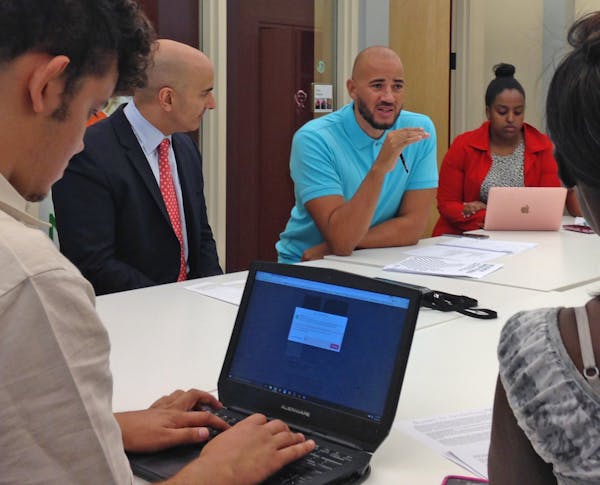American Indians have found community on Franklin Avenue in Minneapolis since the 1970s, but they have struggled to find economic success.
Neel Kashkari, the president of the Federal Reserve Bank of Minneapolis, visited Franklin Avenue on Monday to try to understand these problems better. He met with several American Indian leaders and heard a lot of discouraging news with some bright spots.
"Statistically it's not heading in the right direction," said Robert Lilligren, a former Minneapolis City Council member and president of the Native American Community Development Institute.
About one in three of the 53,000 American Indians in Minnesota lives in poverty, and their median household income is about half that of the state's white majority, according to the latest data from the Census Bureau. Nationally, the numbers aren't much better.
Under then-President Narayana Kocherlakota, the Minneapolis Fed last year started a national Center for Indian Country Development to try to help address persistent poverty in Indian communities.
The bank, whose region stretches from northern Wisconsin to Montana and includes several large reservations, will focus on land, business and entrepreneurship, housing and homeownership and education.
Kashkari spent a few hours Monday asking questions and learning about the challenges faced by American Indians, only about half of whom are employed nationally, according to census data.
"What this community needs is jobs," said Sharon Day, executive director of the Indigenous Peoples Task Force.
Kashkari asked what the obstacles are for Indian youths in finding work, noting that he sees a lot of help-wanted signs.
Many young American Indians are highly mobile or homeless, Day said. Their parents have lost their birth certificates or other paperwork, and they can't find transportation.
"A lot of it is patterns," said Elaine Salinas, of MIGIZI Communications. Many American Indian children do not have examples of professional success to follow, she said.
"My parents were such a big role model for me because they got up every day and went to work," she said.
Much of Monday's discussion centered on education, a subject of emphasis at the Minneapolis Fed, which has done a lot of research into early childhood education.
American Indian children entering kindergarten are "at least 40 points behind" Minneapolis School District averages when they start school, said Danielle Grant, the head of Achieve Minneapolis.
A child's academic and professional success is not of paramount importance for many American Indian parents, she said. More important to them is that their children "know who they are," and don't lose their culture.
Kashkari was intrigued by this. For parents of Indian-American children like him, it's the other way around. Academic and professional success was his mother's chief concern, he said. Culture came second.
The roots of American Indian attitudes toward education are in history. The school system has alienated American Indians since the beginning, treating their culture as deficient, several leaders told Kashkari on Monday.
"Education was used as an aggressive and sometimes brutal tool to enforce assimilation," Lilligren said. "This is my grandmother. Not that long ago … So there's a cultural relationship with education."
Minneapolis Public Schools has found ways to bridge this gap.
Children who enter kindergarten from Anishinabe Academy's prekindergarten program — where classes are conducted in native languages for several hours each day — surpass district averages and perform far better than their peers.
The language immersion component is doubly beneficial, Grant said. It satisfies Indian parents' primary wish that their children learn about their heritage, but learning a second language is also excellent for brain development, auguring for academic success.
"It's a draw for families," Grant said. "And it's really good for students as well."
Adam Belz • 612-673-4405 Twitter: @adambelz
